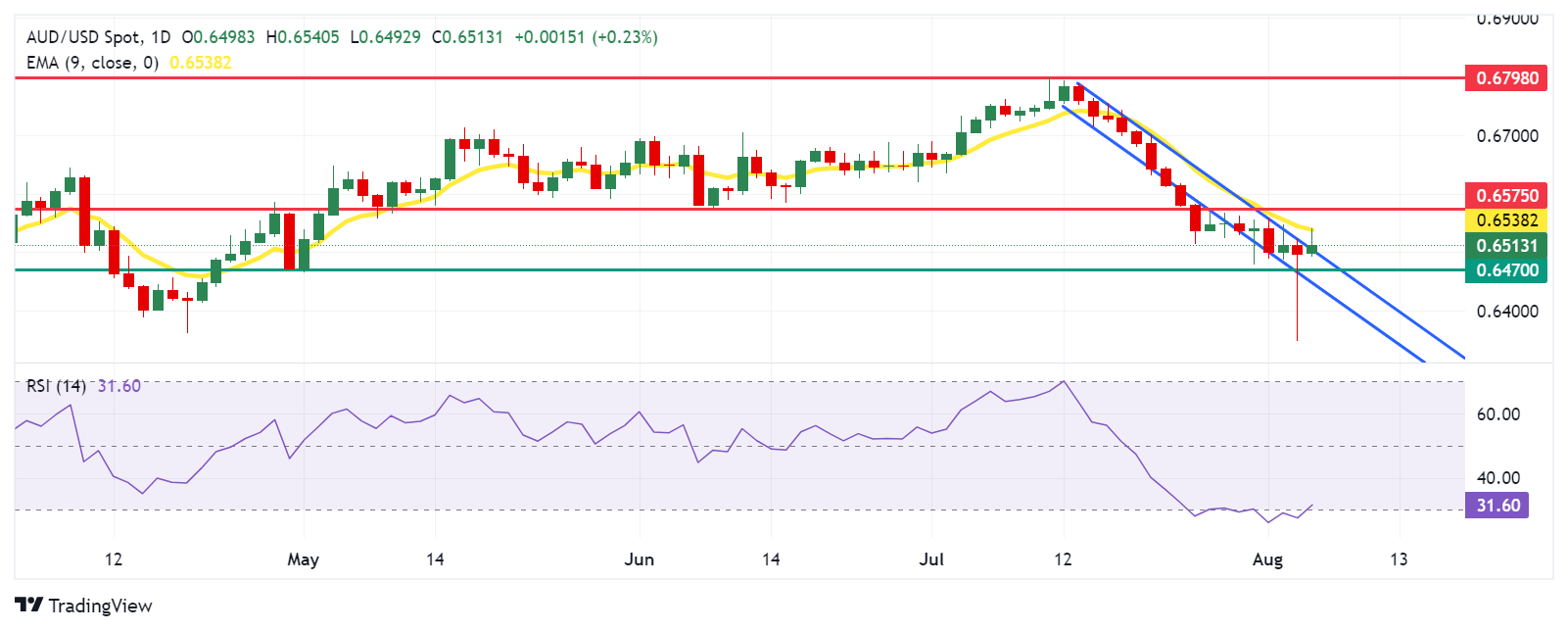- The Australian Dollar remains steady after the RBA interest rate decision.
- The RBA maintained the Official Cash Rate at 4.35% for the sixth consecutive meeting.
- The US Dollar faced challenges as recent downbeat labor data fueled higher odds of a Fed rate cut in September.
The Australian Dollar (AUD) remains stronger following the Reserve Bank of Australia's (RBA) monetary policy decision on Tuesday. The RBA maintained the Official Cash Rate (OCR) at 4.35% for the sixth time. After the central bank's policy decision, RBA Governor Michele Bullock addressed the press conference, emphasizing the need to stay on course with inflation. Bullock highlighted the ongoing risk that inflation might take too long to return to target and noted that interest rates might need to remain higher for an extended period. Bullock stated that a near-term reduction in the cash rate does not align with their current strategy.
The AUD faced challenges against the US Dollar (USD) due to central banks’ rapid policy adjustments and increasing fears of a hard landing for the US economy. Additionally, the second-quarter inflation data has diminished expectations for another RBA rate hike. Markets estimate an RBA rate cut in November, a move anticipated much earlier than previously forecasted for April next year.
The US Dollar loses ground as expectations grow for a 50-basis point (bps) interest rate cut by the US Federal Reserve (Fed) in September. The CME FedWatch tool indicates a 74.5% probability of this relatively larger cut occurring at the September meeting, a significant increase from the 11.4% chance reported a week earlier.
Daily Digest Market Movers: Australian Dollar advances ahead of RBA policy decision
- Federal Reserve Bank of San Francisco President Mary Daly expressed increased confidence on Monday that US inflation is moving towards the Fed's 2% target, according to Reuters. Daly noted that “risks to the Fed's mandates are becoming more balanced and that there is openness to the possibility of cutting rates in upcoming meetings.”
- Chicago Fed President Austan Goolsbee stated on Monday that the US central bank is prepared to act if economic or financial conditions worsen. Goolsbee emphasized, "We're forward-looking about it, and so if the conditions collectively start coming in like that on the through line, there’s deterioration on any of those parts, we’re going to fix it.” according to Reuters.
- US ISM Services PMI rose to 51.4 in July, from the previous reading of 48.8 reading. The index has exceeded the market expectation of 51.0 reading.
- The Judo Bank Australia Composite PMI dropped to 49.9 in July from 50.2 in June, falling below the neutral 50 mark for the first time since January. The Services PMI decreased to 50.4 in July from 51.8 in June. While this represents the sixth consecutive month of expansion in services activity, the growth rate was marginal and the slowest observed in this sequence.
- US Nonfarm Payrolls (NFP) increased by 114K in July from the previous month of 179K (revised down from 206K). This figure came in weaker than the expectation of 175K, data showed on Friday.
- US Average Hourly Earnings eased to 0.2% month-over-month in the same reported period, below the market consensus of 0.3%. On an annual basis, the figure decreased to 3.6% from the previous reading of 3.8%.
- On Tuesday, China's Caixin Services Purchasing Managers Index (PMI) rose to 52.1 in July, from June's 51.2 reading. The index has exceeded the market expectation of a 51.4 reading. Last week, Caixin Manufacturing PMI posted a reading of 49.8 for July, falling short of the expected reading of 51.5 and the previous reading of 51.8. Since both nations are close trade partners, volatility in the Chinese economy can significantly impact the Australian market.
Technical Analysis: Australian Dollar moves above 0.6500
The Australian Dollar trades around 0.6520 on Tuesday. The daily chart analysis shows that the AUD/USD pair has breached above the descending channel, indicating a weakening of a bearish bias. The 14-day Relative Strength Index (RSI) is slightly up from the oversold 30 level, which suggests a potential for more upward correction.
The AUD/USD pair could find immediate support around the throwback support of 0.6470 level, followed by the lower boundary of the descending channel around the level of 0.6450
On the upside, resistance is first encountered at the nine-day Exponential Moving Average (EMA) at 0.6540, followed by the "throwback support turned resistance" at 0.6575 level. A breakout above the latter could propel the AUD/USD pair toward a six-month high of 0.6798.
AUD/USD: Daily Chart
Australian Dollar PRICE Today
The table below shows the percentage change of Australian Dollar (AUD) against listed major currencies today. Australian Dollar was the strongest against the Japanese Yen.
| USD | EUR | GBP | JPY | CAD | AUD | NZD | CHF | |
|---|---|---|---|---|---|---|---|---|
| USD | 0.01% | 0.02% | 1.11% | -0.05% | -0.13% | 0.26% | 0.47% | |
| EUR | -0.01% | 0.04% | 1.09% | -0.07% | -0.17% | 0.17% | 0.47% | |
| GBP | -0.02% | -0.04% | 1.06% | -0.08% | -0.19% | 0.15% | 0.39% | |
| JPY | -1.11% | -1.09% | -1.06% | -1.17% | -1.23% | -0.92% | -0.51% | |
| CAD | 0.05% | 0.07% | 0.08% | 1.17% | -0.09% | 0.25% | 0.48% | |
| AUD | 0.13% | 0.17% | 0.19% | 1.23% | 0.09% | 0.35% | 0.58% | |
| NZD | -0.26% | -0.17% | -0.15% | 0.92% | -0.25% | -0.35% | 0.28% | |
| CHF | -0.47% | -0.47% | -0.39% | 0.51% | -0.48% | -0.58% | -0.28% |
The heat map shows percentage changes of major currencies against each other. The base currency is picked from the left column, while the quote currency is picked from the top row. For example, if you pick the Australian Dollar from the left column and move along the horizontal line to the US Dollar, the percentage change displayed in the box will represent AUD (base)/USD (quote).
RBA FAQs
The Reserve Bank of Australia (RBA) sets interest rates and manages monetary policy for Australia. Decisions are made by a board of governors at 11 meetings a year and ad hoc emergency meetings as required. The RBA’s primary mandate is to maintain price stability, which means an inflation rate of 2-3%, but also “..to contribute to the stability of the currency, full employment, and the economic prosperity and welfare of the Australian people.” Its main tool for achieving this is by raising or lowering interest rates. Relatively high interest rates will strengthen the Australian Dollar (AUD) and vice versa. Other RBA tools include quantitative easing and tightening.
While inflation had always traditionally been thought of as a negative factor for currencies since it lowers the value of money in general, the opposite has actually been the case in modern times with the relaxation of cross-border capital controls. Moderately higher inflation now tends to lead central banks to put up their interest rates, which in turn has the effect of attracting more capital inflows from global investors seeking a lucrative place to keep their money. This increases demand for the local currency, which in the case of Australia is the Aussie Dollar.
Macroeconomic data gauges the health of an economy and can have an impact on the value of its currency. Investors prefer to invest their capital in economies that are safe and growing rather than precarious and shrinking. Greater capital inflows increase the aggregate demand and value of the domestic currency. Classic indicators, such as GDP, Manufacturing and Services PMIs, employment, and consumer sentiment surveys can influence AUD. A strong economy may encourage the Reserve Bank of Australia to put up interest rates, also supporting AUD.
Quantitative Easing (QE) is a tool used in extreme situations when lowering interest rates is not enough to restore the flow of credit in the economy. QE is the process by which the Reserve Bank of Australia (RBA) prints Australian Dollars (AUD) for the purpose of buying assets – usually government or corporate bonds – from financial institutions, thereby providing them with much-needed liquidity. QE usually results in a weaker AUD.
Quantitative tightening (QT) is the reverse of QE. It is undertaken after QE when an economic recovery is underway and inflation starts rising. Whilst in QE the Reserve Bank of Australia (RBA) purchases government and corporate bonds from financial institutions to provide them with liquidity, in QT the RBA stops buying more assets, and stops reinvesting the principal maturing on the bonds it already holds. It would be positive (or bullish) for the Australian Dollar.
Information on these pages contains forward-looking statements that involve risks and uncertainties. Markets and instruments profiled on this page are for informational purposes only and should not in any way come across as a recommendation to buy or sell in these assets. You should do your own thorough research before making any investment decisions. FXStreet does not in any way guarantee that this information is free from mistakes, errors, or material misstatements. It also does not guarantee that this information is of a timely nature. Investing in Open Markets involves a great deal of risk, including the loss of all or a portion of your investment, as well as emotional distress. All risks, losses and costs associated with investing, including total loss of principal, are your responsibility. The views and opinions expressed in this article are those of the authors and do not necessarily reflect the official policy or position of FXStreet nor its advertisers. The author will not be held responsible for information that is found at the end of links posted on this page.
If not otherwise explicitly mentioned in the body of the article, at the time of writing, the author has no position in any stock mentioned in this article and no business relationship with any company mentioned. The author has not received compensation for writing this article, other than from FXStreet.
FXStreet and the author do not provide personalized recommendations. The author makes no representations as to the accuracy, completeness, or suitability of this information. FXStreet and the author will not be liable for any errors, omissions or any losses, injuries or damages arising from this information and its display or use. Errors and omissions excepted.
The author and FXStreet are not registered investment advisors and nothing in this article is intended to be investment advice.
Recommended content
Editors’ Picks

AUD/USD: Bulls continue to target 0.6300
AUD/USD traded in a tight range and faltered once again just ahead of the key 0.6300 hurdle on the back of the renewed buying interest in the US Dollar and the widespread knee-jerk in the risk complex.

EUR/USD: Further gains look at 1.0600 and above
The weekly recovery in EUR/USD gave signs of some loss of momentum despite the pair hit new three-week highs around 1.0460 in a context dominated by the resurgence of the bid bias around the Greenback.

Gold remains on track to challenge record peaks
Gold price sticks to positive bias for the third successive day on Wednesday and trades near its highest level since November 1 above $2,750. The uncertainty around US President Donald Trump's trade policies turns out to be a key factor that continues to drive haven flows towards the precious metal.

Dogecoin Price Prediction: Bulls target $0.40 rally as Trump officially launches Elon Musk’s DOGE
Dogecoin price rose 5% on Wednesday to reclaim $0.38 as Donald Trump signed the DOGE department into law. Media reports linking the Dogecoin logo to the official DOGE website sparked bullish speculations that a $0.50 breakout could be imminent.

Netflix posts record quarter, as Trump talks tariffs on China
There has been a positive tone to risk this week, as the market digests Trump 2.0. However, Trump is not the only show in town. Earnings reports are also a key driver of stock indices, and the news is good.

Trusted Broker Reviews for Smarter Trading
VERIFIED Discover in-depth reviews of reliable brokers. Compare features like spreads, leverage, and platforms. Find the perfect fit for your trading style, from CFDs to Forex pairs like EUR/USD and Gold.
